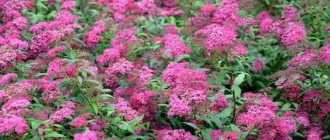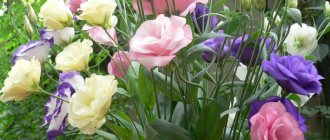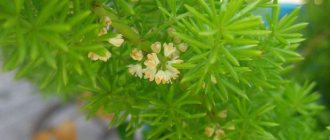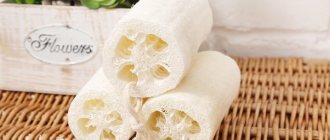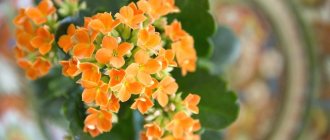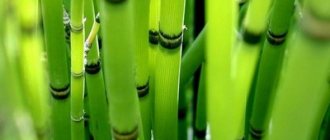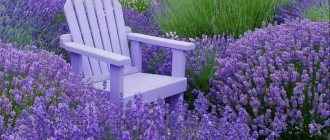Botanical description
Barberry bears fruit abundantly with large, often edible berries, which are used as food in many cuisines around the world. The elegant appearance of the ornamental plant is actively used in landscape design. Dwarf varieties of barberry are grown at home.
The plant does not require special care and attention, it has drought-resistant and frost-resistant qualities. It reproduces well by all popular gardening methods. It does not require constant fertilizing, rarely gets sick, and takes root well in any soil.
Gorgeous specimen with pinkish leaves
Barberry is called a candy bush at the suggestion of Soviet confectioners, who gave its name to their famous caramels. But if you look at the large, ripe and bright fruits of the plant, it’s really hard not to associate them with a sweet delicacy.
There are varieties with evergreen, partially deciduous and deciduous crowns. The leaves grow in bunches in regular order. Thin branches covered with thorns tend upward at an acute angle.
Depending on the type and variety, the shrub can reach a height of 30 cm to 3 m. The crown of the latter in adulthood acquires columnar, spherical or spreading outlines. The average age of an individual is 35-50 years.
Sharp spines and ripe fruits
Barberry blooms in late spring and early summer in a bright palette of shades: violet, purple, red, pink, yellow, white, green, variegated. Flowering lasts 2-3 weeks. Towards the beginning of autumn, oblong oval-shaped berries, red, black or burgundy, appear.
The fruits do not spoil on the branches for a long time, even in winter diluting the snow-white landscape with the rich colors of summer. Most barberry species are honey plants.
Fresh honey has a medium consistency, sweet taste and golden hue.
Barberry: cultivation and care requirements.
Planting barberry and caring for the plant in open ground is not difficult even for beginners. It is advisable to plant barberry from September to November or from March to April.
Rooted seedlings in containers can be planted all year round. Barberries prefer sandy and permeable soils with a neutral pH, but they do not need particularly fertile soil. You can also grow barberry in a pot.
The basic rules for planting barberry do not differ from planting other shrubs; the width of the planting hole should be a quarter greater than the size of the root system.
Ornamental barberry bushes are drought-resistant. They grow well in both sunny and shaded areas, although their leaves are less colorful then. The best location for most barberries is a sunny or slightly shaded location.
Depending on the species, barberry's climate requirements may differ. Those that shed their leaves for the winter are the most resistant to frost. Evergreen varieties are much more tender and difficult to grow in our climate. They may be more sensitive to frost and grow better in protected areas.
Halo of growth
The plant is a typical inhabitant of almost the entire territory of the Northern Hemisphere, with the exception of permafrost latitudes. For decorative and cultural purposes, it is bred in Europe, the Far East, China, Japan, Central Asia, North America, the Caucasus, Persia, Siberia, and Crimea.
The shrub tolerates temperature changes typical of a temperate continental climate. Some varieties are insulated for the winter, others are quite frost-resistant. Heat is also not a big problem for barberry.
Luxurious palette of plant shades
Grows in any soil, even with a composition poor in nutrients. The small root system allows the tree to easily get along with other vegetation.
The main requirement for environmental conditions is the absence of stagnation of moisture in the roots and a sufficient amount of light.
Barberry tolerates drought much better than excess water. It is able to grow in the shade, but in this case the color of the foliage will not be bright and saturated. Fruiting will also not be abundant.
Areas where barberry grows in Russia
Many people are interested in where barberry grows, besides gardeners’ plots. In the wild, the common species grows in the south of Russia, in the Crimea, where it finds the most favorable conditions for growth and is sometimes found in large groups.
It also grows on the Black Sea coast, on the border with Dagestan. Individual bushes grow in the southern regions of the European part of Russia, but these are rare, wild populations. Found in mountainous and hilly areas of the Caucasus, prefers forest edges and hills.
Thunberg's barberry grows only in the Far Eastern territories of Russia.
The Amur species grows as a single bush or in small groups on the edges of mixed and deciduous forests, as well as along river banks on gravelly soils. Other varieties of barberry are found in deciduous and mixed forests of the Khabarovsk Territory, on ventilated and rocky slopes.
We recommend checking out Barberry Pow Wow
The Siberian species is a characteristic plant for steppe rocky mountain slopes, rocks and placers. It is found in the altitudinal zones of Altai, from the steppe zone to the upper border of the forest. The species is most common in the mountains of the Tannu-Ola, Sangilen, and Tsagan-Shibetu ranges.
Popular types and varieties
According to modern taxonometry, the genus Barberry has almost 600 plant species. Most of them are bred for decorative purposes. This includes both giant plants and low-growing individuals.
Dwarf representative of the genus
Many species are divided into separate varieties, which further increases the number of variations of the shrub. Let's look at popular varieties of barberry, the best for growing in Russian regions. Some of them are edible, others are grown for pharmacological, aesthetic and other purposes.
Thunberg
Thunberg Under natural conditions, the species grows in China and Japan. This is an elegant deciduous shrub whose crown color palette includes all shades of red, yellow, orange and green. It tolerates frost and drought well, is not afraid of pests, and grows in an urban environment in rocky soil without fertilizers.
- Thunberg Erecta . An erect, pyramidal bush with bright green leaves of regular, oval shape. The crown is thick and dense. The average height of an individual is 1.2-1.5 m. The flowers are yellow and pale red.
- Thunberg Admiration . A miniature, dwarf tree with a wide, round top, which can reach 1 meter in diameter. Moreover, the height of an adult specimen rarely exceeds 50 cm. The leaves have yellow, red and orange colors with a clear, light edging.
- Thunberg Coronite . Neat bushes up to one and a half meters high with vertical shoots. The oblong, soft pink leaves have a light green edge. The flowers are yellow, the fruits are juicy red.
- Thunberg Golden Rocket . Yellow barberry with a pyramidal crown, growing up to 1-1.2 m. It is distinguished by lush green-yellow foliage and bright yellow flowers. Grows well in many regions of Russia.
- Thunberg's Harlequin . A wide, spreading bush, approximately 2*2 meters, with purple leaves with white and yellow spots. Tolerates frost and lack of water very well. Requires regular pruning to shape.
- Thunberga Atropurpurea . A plant with purple leaves and a tall oval crown. It blooms with yellow-purple flowers and produces deep coral-colored fruits.
Tibetan
Tibetan Natural habitat - Eastern China, Northern India, mountains of Tibet. Asian barberry is considered one of the most useful plants among all members of the genus. The healing basket of scarlet fruits of the plant is especially famous.
The trees grow up to 3.5-4 meters, the branches grow widely upward and to the sides. The dark green leaves curl into tubes, and the flowers have an unusual purple color.
Goji variety Shambhala . A very thorny shrub, up to 3.5 meters high. It is famous for its famous goji berries, which are credited with healing powers in the treatment of cancer and other dangerous diseases. This barberry grows in any soil except swampy soil.
Canadian (Ottawa)
Canadian (Ottawa) Varieties of this species are united by red foliage and a dense, spreading crown. The color of the leaves varies from dark purple to deep scarlet. It is not very widespread in Russia, it is more often found in Siberia and the Urals, due to its frost-resistant qualities.
- Superba . Purple shrub with yellow crown and red berries. It grows quickly and vigorously and requires regular pruning. Unpretentious, drought-resistant.
- Auricoma . Burgundy foliage with silver tints. It grows compactly but voluminously.
- Silver Miles . A low tree up to 3 meters high. Leaf color ranges from purple to burgundy. The flowers are yellow-red, small, and grow abundantly.
Amursky
Amur This type of barberry is found naturally in the Far East, China and Japan. The varieties are usually tall - from 2 to 3.5 meters, the crown is not dense, spreading.
In summer it is bright green with yellow petals. The berries are eaten and medicinal tinctures are prepared from them. The bark is used for mosaic finishing.
Common (evergreen)
Common (evergreen) Large, slow-growing shrub with narrow, long leaves. They do not fall off in the fall and remain on the branches throughout the frost period. In the spring, when a new crown begins to grow, the old leaves dry out and fall off.
The plant is not afraid of frosts down to -35°C, so it is actively grown in central Russia, Siberia, and the Urals. It rarely becomes the target of pest attacks and does not suffer in organically weak soil.
Grows well in a polluted urban atmosphere:
- Alba variety . A beautiful fluffy shrub with unusual white fruits. Grows in Crimea and the Caucasus.
- Variety Lutea . The light yellow berries are eaten. Abundant fruiting is possible only in a bright, sunny area.
Korean
Korean The plant's homeland is the Korean Peninsula, its rocky slopes, gorges, and mountainous regions. Large ovate leaves are green in summer and turn red in autumn. The spines are flattened, long, thick.
The fruits are bright red, perfectly round in shape, 10-12 mm in diameter. The shrub does not tolerate severe frosts and prolonged thaws.
Varieties
Today there are about 600 varieties of barberry; in Russia, the most common is common barberry; the plant tolerates cold well and produces a good harvest.
Some varieties are used only for decorative purposes. The most beautiful of them are the following:
- Red Carpet, soft green to golden foliage with scarlet berries. A bush with curved and spreading branches strewn with thorns. Tolerates frost well, does not like waterlogging. It is better to plant the plant on alkaline soils and away from paths;
- Cabernet, a horizontal bush with crimson-colored leaves that turn wine-colored in summer and red-orange in fall. The crown must be trimmed annually to maintain its shape;
- Maria, in the spring the foliage is golden, in the fall it turns red. The bush needs pruning 2 times a year, grows slowly and does not like drafts;
- Aurea, a bush with yellow or greenish foliage, the crown is formed horizontally. Grows up to 1 meter wide and 80 cm high. It withstands frosts well and is not picky about the type of soil; it does not like strong winds. Grows very slowly;
- Orange Rocket, an upright, narrow shrub with deep orange foliage that turns reddish in fall. Looks beautiful in group planting;
- Golden Rocket, a bush with fragile branches that often freeze and break under the weight of snow. Therefore, for the winter, the plant is tied or wrapped in a net. Grows up to 70 cm in height, leaves are golden-green;
- Rose Glow, the bark of the bush is variegated pink, on an adult bush the leaves and branches are bluish, purple-violet. The plant grows up to 1.5 meters in height;
- Harlequin grows up to 1.5 meters in height and up to 2 meters in width. Foliage and branches are variegated dark pink with purple streaks;
- Admiration, the bush grows up to half a meter in height, the crown is thick and spherical. In summer, barberry leaves are orange and yellow, and by autumn they become scarlet, with a yellow edge. Flowering begins in May, red berries ripen in September;
- Coronita, grows up to 1.5 meters in height and 1 meter in width. The leaves on young branches are bright red, on last year's branches they are dark purple. In both cases, the leaves have a yellow border.
Planting in open ground
The plant is planted in the spring, with the onset of the first warm days. It is important that the buds on the shoots have not yet blossomed. The shrub takes root well and rarely dies when planted.
If you purchased seedlings with a closed root system, they can be planted in the fall, a month before the onset of frost, no later than mid-October. Such a shoot grew in a special container, its roots are well formed, not exposed, and are in their native earthen coma.
Therefore, it will survive the winter well, especially if you additionally wrap the young bush with branches and throw snow on top.
Planting barberry bushes
For rich color and picturesqueness of the future shrub, you should choose a sunny place for planting. Barberry grows in the shade, but the color of the foliage becomes dull, the bright leaves turn green. Individuals with multi-colored shades on the petals and crown are especially light-loving.
The soil can be sandy, rocky, clayey - it is important that it is not excessively moist, as happens in wetlands. To prevent moisture from stagnating in the roots, take care of a good drainage layer. Broken brick, pebbles, crushed stone, and any medium-sized stones are suitable.
Shrub seedlings
Step-by-step instructions for planting barberry:
1The hole is dug 10-14 days before planting. The optimal size is 50*50*50 cm. If you plan to plant several plants, the distance between the holes should be 1-1.5 m. For a hedge – 0.5 m.
2Fill up a small amount of sand and lay drainage.
3Add a layer of mixed soil and humus.
4For additional nutrition, add 100 g of simple mineral fertilizer based on phosphorus.
5 Place the seedling vertically and carefully straighten the roots.
6Fill with soil up to the level of the neck of the root system. Lightly press down the soil. The bush must be tightly fixed.
7The top layer of soil is mulched with organic material. This layer will additionally fertilize the soil and maintain the desired temperature and humidity in the root system. Reception allows you to improve air-gas exchange, which facilitates the nutrition of the newly grown shrub.
8The final stage is watering the plant and trimming the tops of the shoots. Leave 5-7 buds for growth to begin.
Features of planting barberry in the country
When planting a decorative perennial garden crop, it is very important to make the right choice of location, as well as to carefully observe the planting regime and the technology for all subsequent care, taking into account the botanical characteristics of the plant.
Selection and preparation of a landing site
The shrubby perennial can easily take root in almost any type of soil. The plant does not require any complex or special care, but has some features due to its botanical characteristics. The place for growing shrubs should be fairly open. The culture tolerates wind and drafts well, which can be considered an undeniable advantage.
However, it is advisable to plant ornamental varieties and varieties with bright foliage in areas with maximum sunlight. It is recommended to grow green-leaved perennial varieties in partial shade. The shrub is unpretentious to basic soil characteristics, but on excessively acidic soils the crop may die. If the soil is acidic, lime should be added. The culture looks very good in group plantings.
How to grow barberry (video)
Timing and technology for planting garden barberry
Planting seedlings must begin in early spring, immediately after the snow melts. The fact is that the decorative perennial wakes up very early, and it is for this reason that all planting activities must be completed before the buds swell and active sap flow.
Planting holes need to be prepared a couple of weeks before planting seedlings. The dimensions of the hole are 40x40 cm with a depth of about 45 cm. In order to improve the supply of oxygen to the root system, a layer of sand 50-60 mm thick must be poured onto the bottom of the hole.
A nutritious soil mixture is added to the pre-prepared planting holes, represented by a bucket of compost or humus, a bucket of high-quality garden soil, a glass of superphosphate, four glasses of slaked lime, and a couple of glasses of ordinary wood ash.
General recommendations for plant care
Despite its unpretentiousness and the absence of special care requirements, in order for barberry to please the eye with a picturesque view, you should follow simple rules of watering, pruning, feeding, pest and disease control.
Watering rules
The shrub is not moisture-loving
The plant is not moisture-loving. In the cool summer period, seasonal precipitation is enough for it. If dry, warm weather sets in, water the bush once every 2 weeks. 10-15 liters of water is enough for an adult shrub and half of this measure for specimens of the first year of life.
Young seedlings need to be moistened 1-2 times a week until complete rooting. You can check whether watering is needed by lightly digging the top layer of soil. If it is dry, add water; if it is wet, wait a couple of days.
Pruning rules
Regular pruning can give your shrub a beautiful shape.
In order for the shrub to grow beautifully, acquire an aesthetic shape and a graceful appearance, it must be pruned regularly. This procedure is performed not only for decorative purposes. In March and October, sanitary pruning is carried out to remove diseased, dried or damaged branches.
The young tree is not pruned in the first year. The first procedure is performed in the second spring, before the buds swell. At the end of summer, the aesthetic appearance of the plant is further adjusted.
Some low-growing varieties have a very dense and dense crown that grows in a regular cone or column. If broken or unhealthy shoots are not visually observed, the plant is not pruned.
Fertilizer and feeding
During the first 3 years of life, barberry only needs the mineral supplements that were added to the soil during planting. An adult plant is fertilized with urea in the spring. This is a fertilizer with a high nitrogen content, which stimulates active growth, promotes rich foliage color, and the formation of a lush crown.
What does urea look like?
Instructions for preparing urea: the product is diluted in proportions - 30 g of dry composition per 10 liters of water.
In the summer, when the plant has finished flowering, it is additionally supplied with any fertilizer with a phosphorus-potassium base. It will strengthen the roots and catalyze the ripening of berries. Has a beneficial, nutritional effect on the soil.
The feed is diluted strictly following the instructions.
Probable diseases
Barberry has excellent immunity to many diseases that plants encounter in the country. It rarely gets sick, is resistant to pest attacks, and does not depend on sudden temperature changes. However, if you overdo it with watering, the process of rotting may begin in the roots, and fungus may appear on the trunk.
Powdery mildew on leaves
Let's look at common barberry diseases and ways to combat them:
1 Among the pests on the foliage you can find aphids and sawflies, and berries are sometimes affected by moths. If the number of insects is small, the bushes are treated with dishwashing detergent: add 3 tablespoons of soapy substance to 1 liter of water and spray from a distance of 0.5 m. If there are a lot of pests, purchase the preparations “Aktellik”, “Karbofos”, “Aktara”.
2 Sometimes the branches are affected by a fungal coating, which is called “powdery mildew”. Outwardly, it looks like white spots, as if sprinkled with flour. Diseased shoots are cut off and burned. The shrub is treated with fungicides.
3 The same substances will save barberry from rust and bacterial cancer. The first appears as red smudges and spots on the tree trunk. The occurrence of the second is indicated by numerous cracks and growths.
In advanced cases, they do not spare the plant and uproot the entire bush. Otherwise, there is a risk of infection of other garden crops. All affected branches are destroyed at the stake.
Wintering
Despite the frost resistance of most species and varieties of barberry, young plants need to be covered for the winter. This applies to specimens under 5 years old. A thin and insufficiently strong root system may not tolerate the cold and die.
Young barberry needs to be covered for the winter
In regions with severe frosts, mature bushes are also wrapped. A hut-like structure is made from spruce branches and dry branches. When snow falls, it is additionally thrown onto the roof of the makeshift house.
Useful properties of the culture
The plant attracts not only its decorative effect. It has long been known for its taste and healing properties. Common barberry is mainly used for medicinal purposes. Its berries are used to make various culinary dishes (compotes, jelly, jelly), and added to vegetables, meat, and rice. The berries contain useful acids, the leaves contain vitamins C, E, and carotenoids. Various parts of the plant are useful.
Barberry remedies help with:
- increased blood pressure;
- inflammation of the gallbladder;
- hepatitis;
- psoriasis;
- pancreatitis;
- high temperature;
- bleeding;
- eczema and other ailments.
Unripe barberry fruits are poisonous. Therefore, they need to be collected only after ripening. After collection, they are dried and stored in a dry place for no more than 3 years.
Barberry is a picky garden crop that will look spectacular on any site. In addition to bright decorative foliage, some species are grown to produce tasty, healthy fruits. Planting and growing barberry is not difficult; anyone can decorate their area with shrubs.
Do you want to know more useful information about growing Barberry on your site? Watch the video:
Reproduction methods
Barberry is bred using all methods known in botany: cuttings, seeds, layering, dividing the bush. The plant takes root equally well when using any of them.
Let's look at each process step by step:
Cuttings
Propagation by cuttings
The method requires constant care of the cuttings.
1At the beginning of summer, fresh shoots 15-20 cm long are cut to obtain cuttings.
2Foliage is removed from below, the cut is treated with any phytohormone.
3The top leaves are cut to half.
4The cuttings are planted in soil made of humus, peat and sand poured into a greenhouse container. A trunk 1/3 of a branch long remains outside.
5The seedlings are watered, covered and ventilated daily.
6They grow in a greenhouse for less than 2 years. In the second spring, seedlings are planted in open ground.
Layerings
This is what propagation by layering looks like
One of the simplest and least labor-intensive methods.
1With the onset of spring, choose strong shoots growing in the lower part of the outer circle of the bush.
2They are bent to the ground and placed in specially dug trenches with drainage, 0.5 m deep.
3Secure with staples, sprinkle soil on top, and mulch.
4Don’t forget to water and feed regularly, just like the mother bush.
5After a year, the branches are cut off from the parent with pruning shears, dug out of the ground along with the formed root system and replanted for growing.
6 Another year later, in the spring, fresh barberry shoots are planted in a permanent place.
Seeds
Barberry seeds
Barberry seeds have a high level of germination.
1In early autumn, the fruits on the bush ripen. They are collected and washed. Every other day, wipe and lay out to dry.
2In the same autumn, a month before the onset of frost, the seeds are planted in open ground in furrows 1-2 cm deep.
3For the winter, the bed is covered with spruce branches.
4In the spring, when the shoots appear, they are thinned out. Leave one seedling every 3-5 cm.
5During the summer, do not forget to regularly water, loosen, weed and fertilize.
6With the onset of the second spring, the seedlings are planted in permanent places.
Please note that with this method of reproduction, young barberries may not retain the characteristics of the mother.
Dividing the bush
Reproduction by dividing the bush
For this method, it is necessary to select plants no older than 5 years.
1In the spring, with the onset of settled warm weather, a young bush is dug up. The buds should not swell yet.
2Use a pruning shear to cut the root system so that at least 3-5 shoots remain on each side.
3The cut site is treated with charcoal and immediately planted in a permanent place.
4Water, mulch, fertilize according to plan.
5Barberry division is used only for propagation of dwarf shrubs. For example, varieties of domestic plants.
Propagation of Thunberg barberry and other species by cuttings in spring
And yet, how to grow barberry of the same variety? To avoid subsequent grafting, it is better to use the cutting method. To do this, it is enough to cut branches from an adult bush, root and plant. But let us immediately note that not all types of barberry can produce good cuttings that will quickly take root. In addition, this method requires quite a lot of time for roots to germinate. To speed up this process, gardeners recommend using special root stimulants.
Reproduction of decorative barberry by cuttings proceeds according to the following scheme:
- the cuttings are on the side branches, they are cut in June, up to 15 cm in size;
- the leaves at the base of the cut are removed, and the cut itself is treated with a root formation stimulator;
- soil is prepared: peat and sand;
- treated cuttings are planted;
- all seedlings are covered with plastic film or jars to create a greenhouse effect.
Propagation of barberry by cuttings in the spring also involves subsequent care of the seedlings: ventilation, loosening the soil, spraying with water.
If the cutting has taken root, you will soon see new leaves on the visible part of it. Next, the rooted plant should be transplanted into a deeper container with loose soil and mineral fertilizers. Here it remains for another year, after which the plant can be transplanted to a permanent place.
See what cuttings of barberry, its planting and care for it look like in the photo:
Recommendations for breeding indoor varieties
At home, low-growing varieties of the Thunberg species grow best. They respond well to frequent decorative pruning, so such plants look aesthetically pleasing and elegant.
Miniature variety Bagatelle
The following varieties are perfect for the home:
- Natasha . Variegated foliage with tints of white, pink and green looks unusual on pinkish branches. An unpretentious plant that grows slowly.
- Erecta . The leaves are regularly rounded and green in color. The bush is decorated by an even, columnar crown that does not grow higher than 80 cm.
- Bagatelle. Dense, spherical shrub with bright purple leaves edged with green. The height of an adult plant does not exceed 30 cm.
For indoor barberries you should choose universal soil . Don't forget to put drainage on the bottom. Watering is done twice a week in summer, autumn and spring, and once in winter.
Spray regularly with water, excluding the flowering period. The pot is placed on the sunny side, with a constant flow of fresh air.
Features of planting in different parts of the country
Amazing winter spectacle
When choosing a suitable variety, they are guided by the weather conditions of the region and the characteristics of the plant’s resistance to them.
1 The mild winters of the Mediterranean, southern regions of the Caucasus and the Black Sea coast make it possible to grow almost any type of barberry. The warm climate promotes favorable growth, abundant flowering and fruiting.
2 The temperate continental climate of the central part of Russia is characterized by hot summers and mild winters with temperatures down to -20-25°C. It is better to wrap the barberry for the winter, and in the summer do not forget to water it when there is no rain.
3 In areas with a high content of groundwater in the soil , which includes the Moscow region, when planting, do not forget about the drainage layer. Its height should be 1/3 of the depth of the planting hole.
4 Frost-resistant barberry varieties take root well in the Urals and Siberia Young plants here are necessarily covered with spruce branches and covered with snow. For those less resistant to the cold, a greenhouse is built.
Barberry Ottawa: description, characteristics
Barberry Ottawa is very decorative - the leaves are purple and the flowers are yellow-red. In the autumn season, the plant is especially attractive - the leaves acquire a rich purple color. Flowering occurs in the first ten days of May and lasts about 14 days.
Varieties
Barberry Ottawa can boast of only three varieties:
- Barberry "Superba" ("Superba") - the height of the bush varies from 2.5 to 3 m. In the summer, the leaves are red with a blue tint, and in the fall their color is varied - from bright orange to deep red. Flowering begins in May, the flowers have a yellow-red hue. The fruits ripen in the second ten days of October;
- Barberry "Aurikoma" - the average height of the bush is 2 m. The leaves and flowers are mostly red in color.
- Barberry "Purpurea" - the plant reaches a height of 2 m. The flowers are yellow-red, the leaves have a dark purple hue.
Use in landscape design
Barberry in landscape design
The variety of colors of barberry foliage and trunks, the decorative shape of the crown and unpretentiousness to urban conditions have determined the frequency of use of different varieties of shrubs in landscaping and landscape design.
It looks spectacular at any time of the year. In spring and summer there is fresh greenery, in autumn there is a fiery fire, and in winter bright fruits decorate the faceless snow-white garden.
A fantastic combination of shades makes the bush stand out equally well both in a single planting and in a group planting, where it often acts as the center of the composition. Hedges made from barberry look gorgeous, especially from several varieties with different crown colors.
The shrub lends itself well to pruning, pliably takes the desired shape, and grows correctly in the indicated direction. Using it, picturesque ensembles are obtained that delight the eyes of passers-by in city squares and parks.
Care
Barberry is a hardy and unpretentious plant, but for a good harvest and a beautiful appearance, the shrub needs care. For the first 2 years after planting, the seedling should be covered with burlap for the winter to protect it from the cold. Mature plants tolerate sub-zero temperatures normally. If branches were damaged during frost, they are pruned back to healthy buds in the spring.
The barberry bush grows quickly, so it needs constant pruning in autumn and spring. This will help give the plant a neat appearance and decorative shape. The first pruning is carried out a year after planting, during which 2/3 of the growth of branches is removed. Hedge trimming is carried out in June and August. It is necessary to water barberry regularly, once every 4-7 days, after planting and in hot weather.
The plant does not need too frequent feeding. The first time barberry is fertilized a year after planting, after that - once every 3-4 years. In the spring, the plant is fed with nitrogen fertilizers, and in the fall with potassium, organic or phosphorus fertilizers. You can combine them with microelements. In July, the complex preparation “Kemira-universal” is applied under the bush in a proportion of 15 g per 10 liters of water.
Application of fruits, foliage and wood
In addition to its chic appearance, the plant is famous for its dense and textured wood . Some of its types are used in turning, as a material for openwork inlay. The wood of many varieties has a rich red, burgundy, yellow or purple hue, so it is actively used for laying out Indian mosaics.
Souvenirs, crafts, and toys are made from solid trunks . They are used to make shoe nails. And from the yellow bark and rhizomes, natural yellow paint is obtained.
Seasoning made from dried fruits
In Tibet, crushed and dried fruits are added to spicy mixtures. In the east, barberry seasoning is used everywhere. It is added to meat fillings, pilaf, and stewed meat dishes.
Due to the content of malic, tartaric and citric acids in unripe fruits, they make excellent marinade and sour sauces. In confectionery, berries are used to make preserves, jams, marshmallows, marmalade, jellies and mousses. Compotes are made from them and exquisite liqueurs are pressed.
Fresh leaves are used to make sour soups, chop them into salads, and add them to canned food . Valuable and healthy tea with barberry flavor is obtained from dried fruits and herbs. In the cosmetology industry, oil extract from fresh barberry berries is added to creams, lotions for hair and face.
Photos of berries
What barberry berries look like and a description of their characteristics can be found in encyclopedias. The fruits are standardly elongated, barrel-shaped, their color range is red-orange, and the taste of the edible berries is tart and sour. They are about 2 cm in length and weigh 3-4 g. It is important to take into account the characteristics of the plant, because Barberry fruits can be edible or decorative.
We recommend that you familiarize yourself with Honeysuckle Malvina
Berries are used in cooking:
- jam;
- syrups;
- medicinal teas;
- vitamin drinks (fruit drinks, jelly, tinctures, compotes or liqueurs);
- marinades;
- medicinal folk remedies.
Heat-treated berries are used in Armenian recipes; pickled berries are served with fried vegetables, lamb, and boiled rice.
It is not recommended to remove green fruits for making dishes and drinks, because... the products contain a high concentration of alkaloids. The fruits ripen in September-October. Edible berries contain acids (citric, tartaric and malic).
The berries are dried in a place without access to sunlight, the optimal temperature is not higher than +50°C. The finished fruits are placed in paper bags or cardboard boxes. The shelf life of dried material is no more than 3 years.
Healing properties
Since ancient times, barberry has been known as a plant with a rich healing potion. Its fruits, bark and leaves contain a lot of nutritious biological substances and beneficial microelements.
Medicinal tea
The medicinal properties of the bush are used in pharmacology, folk and traditional medicine:
- A decoction of the fruits of the plant has a hemostatic function. Regular use normalizes blood pressure and strengthens blood vessels
- barberry compote is famous as an effective antiviral agent. It is good for respiratory diseases
- Plant-based medicines normalize metabolic processes, remove waste and toxins. They increase appetite and help food digest properly
- there are studies proving the effectiveness of barberry treatment of malignant cancer diseases
- tea eliminates headaches, improves mood, acts as a good anti-stress remedy
Specific substances in the composition may cause an allergic reaction.
Tasty and healthy fruits will improve the health of the whole family, and homemade seasoning from dried berries will give new dishes a refined and unusual taste.
The plant is included in the list of components that promote healthy longevity.
Planting barberry in your garden is something even a novice gardener can do. Minimal care for most varieties will not cause any trouble and will not take much time. The picturesque coloring of the shrub will delight you with its appearance all year round.
Watch a short video about simple rules for planting a candy plant:
Barberry: care
Most barberry varieties do not require special care. These are frost-resistant plants that can withstand drought, scorching sun and shade. If something harms them, it is flooding and excess moisture. However, evergreen varieties should be watered occasionally in the fall.
The most important element of plant care is pruning. This is very beneficial for them and ensures healthy growth of the bushes. Every year after winter, old wilted shoots should be cut back to give the plant room for new shoots.
At least once every three years, barberry requires more severe pruning. When pruning barberries, you should wear thick gloves to protect your hands from thorns.

